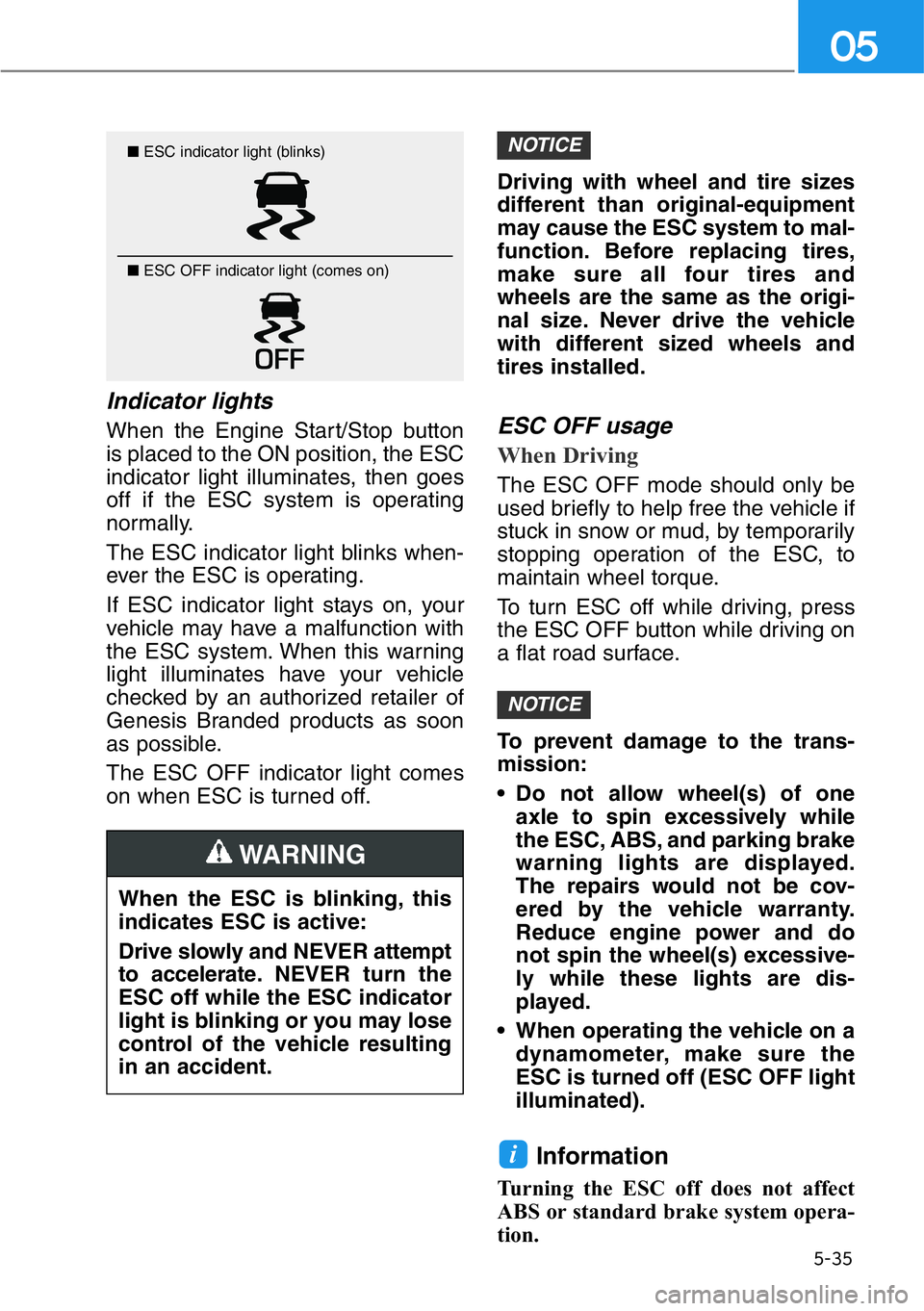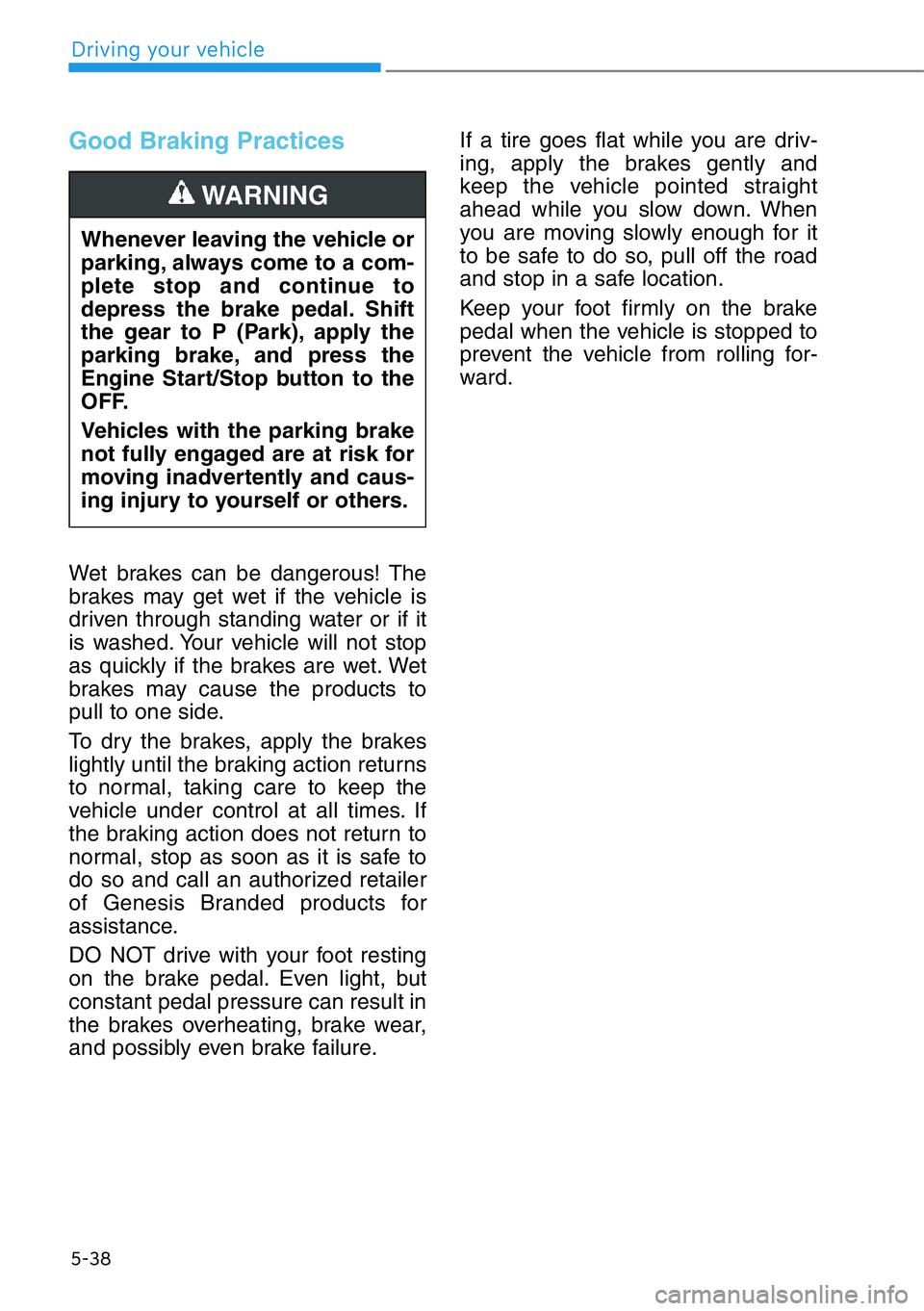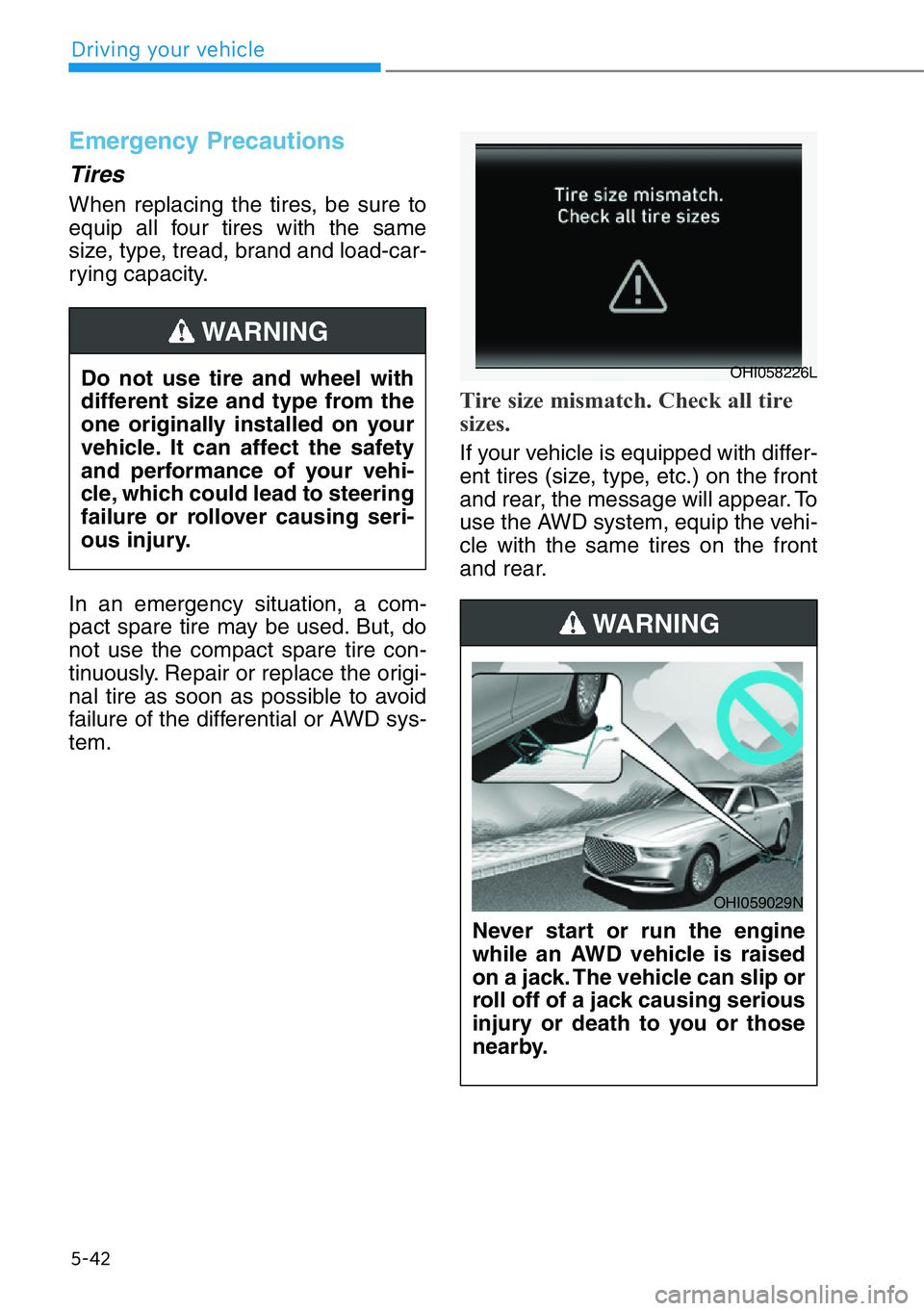warning GENESIS G90 2021 Owner's Manual
[x] Cancel search | Manufacturer: GENESIS, Model Year: 2021, Model line: G90, Model: GENESIS G90 2021Pages: 538, PDF Size: 13.02 MB
Page 286 of 538

5-34
Driving your vehicle
ESC OFF condition
To cancel ESC operation:
• State 1
Press the ESC OFF button briefly.
The ESC OFF indicator light and
message "Traction Control disabled"
will illuminate. In this state, the trac-
tion control function of ESC (engine
management) is disabled, but the
brake control function of ESC (brak-
ing management) still operates.• State 2
Press and hold the ESC OFF button
continuously for more than 3 sec-
onds. The ESC OFF indicator light
and message "Traction and Stability
Control disabled" illuminates and a
warning chime sounds. In this state,
both the traction control function of
ESC (engine management) and the
brake control function of ESC (brak-
ing management) are disabled.
If the Engine Start/Stop button is
pressed to the OFF position when
ESC is off, ESC remains off. Upon
restarting the engine, the ESC will
automatically turn on again.
OHI058044L
OHI058045L
Page 287 of 538

5-35
05
Indicator lights
When the Engine Start/Stop button
is placed to the ON position, the ESC
indicator light illuminates, then goes
off if the ESC system is operating
normally.
The ESC indicator light blinks when-
ever the ESC is operating.
If ESC indicator light stays on, your
vehicle may have a malfunction with
the ESC system. When this warning
light illuminates have your vehicle
checked by an authorized retailer of
Genesis Branded products as soon
as possible.
The ESC OFF indicator light comes
on when ESC is turned off.Driving with wheel and tire sizes
different than original-equipment
may cause the ESC system to mal-
function. Before replacing tires,
make sure all four tires and
wheels are the same as the origi-
nal size. Never drive the vehicle
with different sized wheels and
tires installed.ESC OFF usage
When Driving
The ESC OFF mode should only be
used briefly to help free the vehicle if
stuck in snow or mud, by temporarily
stopping operation of the ESC, to
maintain wheel torque.
To turn ESC off while driving, press
the ESC OFF button while driving on
a flat road surface.
To prevent damage to the trans-
mission:
• Do not allow wheel(s) of one
axle to spin excessively while
the ESC, ABS, and parking brake
warning lights are displayed.
The repairs would not be cov-
ered by the vehicle warranty.
Reduce engine power and do
not spin the wheel(s) excessive-
ly while these lights are dis-
played.
• When operating the vehicle on a
dynamometer, make sure the
ESC is turned off (ESC OFF light
illuminated).
Information
Turning the ESC off does not affect
ABS or standard brake system opera-
tion.
i
NOTICE
NOTICE■ESC indicator light (blinks)
■ ESC OFF indicator light (comes on)
When the ESC is blinking, this
indicates ESC is active:
Drive slowly and NEVER attempt
to accelerate.NEVER turn the
ESC off while the ESC indicator
light is blinking or you may lose
control of the vehicle resulting
in an accident.
WARNING
Page 288 of 538

5-36
Driving your vehicle
Vehicle Stability Management
(VSM)
The Vehicle Stability Management is
a function of the Electronic Stability
Control system. It helps the vehicle
stay stable when accelerating or
braking suddenly on wet, slippery
and rough roads where traction over
the four tires can suddenly become
uneven.
VSM operation
VSM ON condition
The VSM operates when:
• The Electronic Stability Control is
on.
• Vehicle speed is approximately
above 9 mph (15 km/h) on curve
roads.
• Vehicle speed is approximately
above 12 mph (20 km/h) when the
vehicle is braking on rough roads.
When operating
When you apply your brakes under
conditions which may activate the
ESC, you may hear sounds from the
brakes, or feel a corresponding sen-
sation in the brake pedal. This is nor-
mal and it means your VSM is active.
The VSM does not operate when:
• Driving on a banked road such
as gradient or incline.
• Driving in reverse.
• The ESC OFF indicator light is
on.
• The MDPS (Motor-Driven Power
Steering) warning light ( ) is
on or blinks.
NOTICE
Take the following precautions
when using the Vehicle Stability
Management :
• ALWAYS check the speed and
the distance to the vehicle
ahead. The VSM is not a sub-
stitute for safe driving prac-
tices.
• Never drive too fast for the
road conditions. The VSM sys-
tem will not prevent acci-
dents. Excessive speed in bad
weather, slippery and uneven
roads can result in severe
accidents.
WARNING
Page 289 of 538

5-37
05
Driving with wheel and tire sizes dif-
ferent than original-equipment may
cause the ESC system to malfunc-
tion. Before replacing tires, make
sure all four tires and wheels are the
same as the original size. Never
drive the vehicle with different sized
tires and wheels installed.
Hill-Start Assist Control (HAC)
The Hill-Start Assist Control helps
prevent the vehicle from rolling back-
wards when starting a vehicle from a
stop on a hill. The system operates
the brakes automatically for approxi-
mately 2 seconds and releases the
brake after 2 seconds or when the
accelerator pedal is depressed.
• The HAC does not operate when
the gear is shifted to P (Park) or
N (Neutral).
• The HAC activates even though
the ESC (Electronic Stability
Control) is off but does not acti-
vate when the ESC has malfunc-
tioned.
NOTICE
If the ESC indicator light ( ) or
MDPS warning light ( ) stays
on or blinks, your vehicle may
have a malfunction with the
VSM system.When the warning
light illuminates, have your vehi-
cle checked by an authorized
retailer of Genesis Branded
products as soon as possible.
WARNING
Always be ready to depress the
accelerator pedal when starting
off on a incline. The HAC acti-
vates only for approximately 2
seconds.
WARNING
Page 290 of 538

5-38
Driving your vehicle
Good Braking Practices
Wet brakes can be dangerous! The
brakes may get wet if the vehicle is
driven through standing water or if it
is washed. Your vehicle will not stop
as quickly if the brakes are wet. Wet
brakes may cause the products to
pull to one side.
To dry the brakes, apply the brakes
lightly until the braking action returns
to normal, taking care to keep the
vehicle under control at all times. If
the braking action does not return to
normal, stop as soon as it is safe to
do so and call an authorized retailer
of Genesis Branded products for
assistance.
DO NOT drive with your foot resting
on the brake pedal. Even light, but
constant pedal pressure can result in
the brakes overheating, brake wear,
and possibly even brake failure.If a tire goes flat while you are driv-
ing, apply the brakes gently and
keep the vehicle pointed straight
ahead while you slow down. When
you are moving slowly enough for it
to be safe to do so, pull off the road
and stop in a safe location.
Keep your foot firmly on the brake
pedal when the vehicle is stopped to
prevent the vehicle from rolling for-
ward. Whenever leaving the vehicle or
parking, always come to a com-
plete stop and continue to
depress the brake pedal. Shift
the gear to P (Park), apply the
parking brake, and press the
Engine Start/Stop button to the
OFF.
Vehicles with the parking brake
not fully engaged are at risk for
moving inadvertently and caus-
ing injury to yourself or others.
WARNING
Page 291 of 538

Using All Wheel Drive (AWD)
The All Wheel Drive system delivers
engine power to front and rear
wheels for maximum traction. AWD is
useful when extra traction is
required, such as when driving on,
muddy, wet, or snow-covered roads.
If the system determines there is a
need for four wheel drive, the
engine's driving power is distributed
to all four wheels automatically.
ALL WHEEL DRIVE (AWD) (IF EQUIPPED)
5-39
05
If the AWD warning light ( )
stays on the instrument cluster,
your vehicle may have a mal-
function with the AWD system.
When the AWD warning light
( ) illuminates have your
vehicle checked by an author-
ized retailer of Genesis Branded
products as soon as possible.
WARNING
To reduce the risk of SERIOUS
INJURY or DEATH:
• Do not drive in conditions that
exceed the vehicles intended
design such as challenging
off-road conditions.
• Avoid high speeds when cor-
nering or turning.
• Do not make quick steering
wheel movements, such as
sharp lane changes or fast,
sharp turns.
• The risk of a rollover is great-
ly increased if you lose con-
trol of your vehicle at highway
speeds.
• Loss of control often occurs if
two or more wheels drop off
the roadway and the driver
over steers to reenter the
roadway.
• In the event your vehicle
leaves the roadway, do not
steer sharply. Instead, slow
down before pulling back into
the travel lanes.
• Always drive safely and use
caution when driving an AWD
vehicle.
WARNING
Page 293 of 538

Driving in sand or mud
• Maintain slow and constant speed.
• Keep sufficient distance between
your vehicle and the vehicle in front
of you.
• Reduce vehicle speed and always
check the road condition.
• Avoid speeding, rapid acceleration,
sudden brake applications, and
sharp turns to prevent getting
stuck.
When the vehicle is stuck in snow,
sand or mud, avoid running the
engine continuously at high rpm,
doing so may damage the tires,
transmission, differential or AWD
system.
Information
• When using Snow Tires, mount
them on all four wheels.
• When using AutoSock
®(fabric snow
chain), install them on the rear tires.
For more information on Snow Tires
and Tire Chains, refer to "Winter
Driving" in this chapter.
Driving up or down hills
• Driving uphill
- Before starting off, check if it is
possible to drive uphill.
- Drive as straight as possible.
• Driving downhill
- Do not change gear while driving
downhill. Select gear before driv-
ing downhill.
- Drive slowly and select Manual
Shift Mode to provide engine
braking while driving downhill.
- Drive straight as possible.
i
NOTICE
5-41
05
Exercise extreme caution driv-
ing up or down steep hills. The
vehicle may flip depending on
the grade, terrain and water/
mud conditions.
WARNING
Page 294 of 538

Emergency Precautions
Tires
When replacing the tires, be sure to
equip all four tires with the same
size, type, tread, brand and load-car-
rying capacity.
In an emergency situation, a com-
pact spare tire may be used. But, do
not use the compact spare tire con-
tinuously. Repair or replace the origi-
nal tire as soon as possible to avoid
failure of the differential or AWD sys-
tem.
Tire size mismatch. Check all tire
sizes.
If your vehicle is equipped with differ-
ent tires (size, type, etc.) on the front
and rear, the message will appear. To
use the AWD system, equip the vehi-
cle with the same tires on the front
and rear.
5-42
Driving your vehicle
Do not use tire and wheel with
different size and type from the
one originally installed on your
vehicle. It can affect the safety
and performance of your vehi-
cle, which could lead to steering
failure or rollover causing seri-
ous injury.
WARNING
OHI058226L
Never start or run the engine
while an AWD vehicle is raised
on a jack. The vehicle can slip or
roll off of a jack causing serious
injury or death to you or those
nearby.
WARNING
OHI059029N
Page 295 of 538

Towing
AWD vehicles must be towed with all
wheels off the ground, either on a
flatbed tow truck or using doilies.
For more details, refer to "Towing"
in chapter 6.
Vehicle inspection
• If the vehicle needs to be operated
on a vehicle lift do not attempt to
stop any of the four wheels for turn-
ing. This could damage the sys-
tem.
• Never engage the parking brake
while running the engine on a car
lift. This may damage the AWD
system.
Dynamometer testing
An AWD vehicle must be tested on a
special four wheel chassis dynamome-
ter.
An AWD vehicle should not be tested
on a 2WD roll tester. If a 2WD roll
tester must be used, perform the fol-
lowing procedure:
1. Check the tire pressures recom-
mended for your vehicle.
2. Place the rear wheels on the roll
tester for a speedometer test as
shown in the illustration.
3. Release the parking brake.
4. Place the front wheels on the tem-
porary free roller as shown in the
illustration.
5-43
05
OHI058031Roll Tester (Speedometer)
Temporary Free Roller
Keep away from the front of the
vehicle while the vehicle is in
gear on the dynamometer. The
vehicle can jump forward and
cause serious injury or death.
WARNING
Page 296 of 538

5-44
Driving your vehicle
Electronic Control Suspension
(ECS)
The Electronic Control Suspension
controls the vehicle suspension
automatically to maximize driving
comfort by taking into account the
driving conditions such as speed,
surface of the road, cornering, stop-
ping requirements and acceleration.
ECS (Electronic Control
Suspension) malfunction indi-
cator
Check Electronic Suspension
If the ECS warning message comes
on, you may have a problem with the
ECS system. Have the system be
checked by an authorized retailer of
Genesis Branded products.
Dynamic Stability Damping
Control (DSDC)
The Dynamic Stability Damping
Control provides comfort riding and
driving stability by meticulously opti-
mizing the suspension power during
sharp curving or abrupt obstacle
avoidance.
Operating conditions
• The DSDC is activated, when driv-
ing speed exceeds 30 mph (50
km/h).
• The DSDC does not operate, when
the Electronic Stability Control is
deactivated.
The Dynamic Stability Damping
Control does not operate, when
there is a malfunction with the
Electronic Stability Control.
The Dynamic Stability Damping
Control operation is limited in fol-
lowing situations:
- There are wide variations in tire
pressures.
- The vehicle is driven on a steep
slope.
- The vehicle is driven on a rough,
rugged surface.
NOTICE
GENESIS ADAPTIVE CONTROL SUSPENSION (IF EQUIPPED)
NEVER install any tires/wheels
in different sizes or of different
models on your vehicle. It may
cause a malfunction of the
Dynamic Stability Damping
Control.
WARNING
OHI048132L